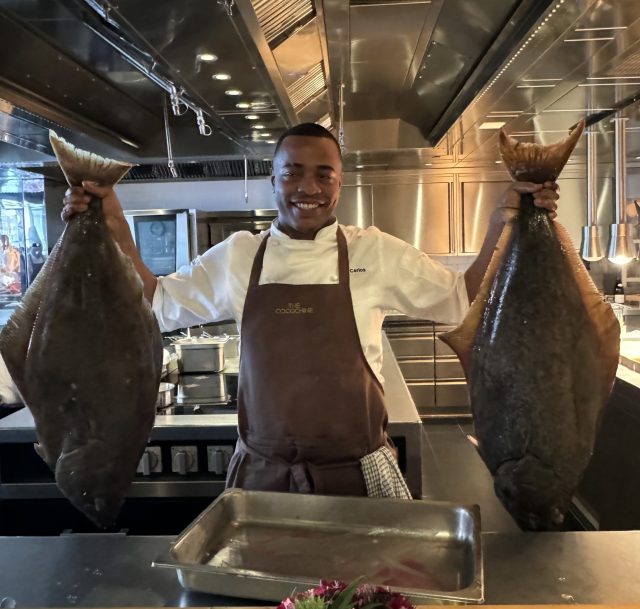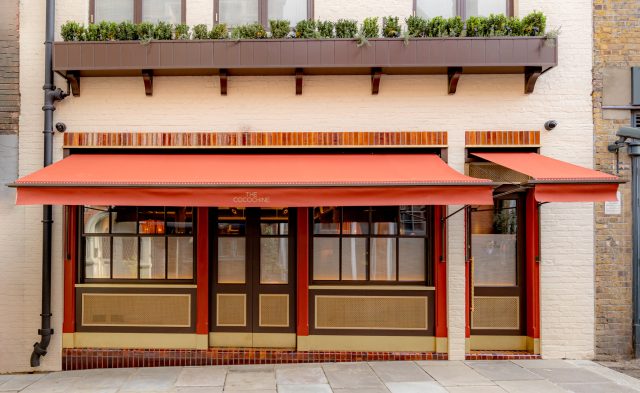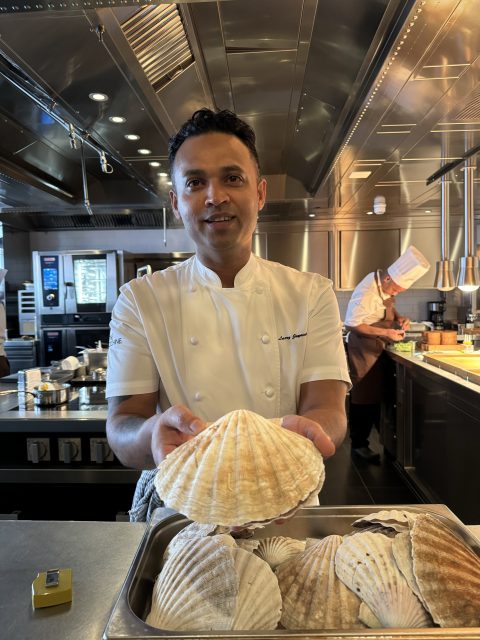This website uses cookies so that we can provide you with the best user experience possible. Cookie information is stored in your browser and performs functions such as recognising you when you return to our website and helping our team to understand which sections of the website you find most interesting and useful.
Wine List Confidential: The Cocochine
Douglas Blyde cracks into an XXL Orkney scallop and looks over the selection of large format bottles at The Cocochine in Mayfair to see if bigger really is better.

“It feels like a chef’s chimera somehow made real; a perfect restaurant of impossible details, built with a blank cheque” wrote David Ellis in Evening Standard, while Vogue’s Hayley Maitland praised the “eye for design and curation” of co-founder Tim Jefferies, including a catalogue of work from Hamiltons Gallery which he also owns.
Design
Taking the affectionate term for Jefferies’ daughter, Coco, who is in turn named after the island in the Maldives on which she was conceived according to Evening Standard, The Cocochine dwells in a four-floor mews house opposite its development kitchen and associated, artfully presented delicatessen, The Rex, with its miso sweet potato and spinach pie. Works include a portrait by Mario Testino in the ground floor 28-seat dining room, replete with original parquet, on which an 1,800kg marble wine alter with plumbed-in ice wells rises.
One floor above, a seven-stool chef’s counter is the best vantage to interact with magnetic head chef, Larry Jayasekara, who undertook a 26-country tour in advance of this opening, which was delayed to perfection. Jayasekara’s kitchen realm runs to 920 square feet, being naturally lit, hence edible plants grow here. The fit is by the Venice-based Marrone. Writhing beneath the retro Bugatti-like seats is the mosaic of a two-headed snake inspired by artist, Guido Mocafico, with metal tails coiling around foot pads.

At the apex is the vaulted, top-floor salon, replete with Warhols, a baronial fireplace, and a dedicated kitchen.
Particular attention has been lavished on lighting, with stairways “washed” in gentle illumination says Jayasekara, whose initials along with Jefferies feature on wall fittings. Even the kitchen is warm in shade. “If I could light a restaurant with just candles, I would,” he adds.
Drinks
Succeeding Elvis Ziakos, the Naples-born, Florence-raised wine director, Marcello Colletti previously worked as head sommelier at Nobu Hotel’s Portman Square branch. Other roles in London included Celeste at The Lanesborough when under the tenure of three Michelin star holding chef Eric Fréchon, and with the eloquent Frederic Bruges at Sketch’s Lecture Room and Library (whose chef also holds such an accolade), as well as Gymkhana, and Roka, and in Manchester, the hugely exciting Mana, around the era of the pandemic. As well as wine, Colletti delights in delving into geography and history, which in any case “equate to gastronomy” he remarked.
Encapsulated in an aromatic, couture handbag-grade leather book, the fruits of the wine list, are viewable down a stairway glossily tiled in colours intended, says Jayasekara “to evoke the northern lights”. With space for “1,254 bottles,” he confirmed, the oak racking is impressively customisable, allowing multiple formats to be placed on the same shelf at different angles.
Adjacent is “Monica’s Room”, with “Mayfair brandy tiles” said Jayasekara. Here, friends of The Cocochine may savour wines with total privacy. “I can close the CCTV,” says Jayasekara, who jokes his guests can get up to whatever they wish, “so long as Marcello doesn’t have too much to clean up afterwards.”

If one asks politely and has the means, ostensibly, every wine is available by the Riedel Veloce glass via either Coravin or the Bermar preservation system. “We don’t govern by anybody’s rules,” said Jayasekara. However, stated wines by the glass on the draft we received two weeks into Colletti’s tenure ranged from 2020 Grandes Coutures Bourgogne Blanc from the hands of six-generation producer, Xavier Monnot’s at £15/125ml, to 2010 Tignanello at £53, while Château d’Yquem’s 2015 (£70/100ml) is a choice sweeter pour.
Ranging from Billecart-Salmon Brut Reserve NV (£105) to, named after the grandfather of Noah, a Methuselah (six litres) of Taittinger Comte de Champagne Rosé 2006 at £7,250, the sparkling selection presently focuses on seven Maisons of champagne, with, despite Colletti’s previously stated fondness in an interview for “Glass of Bubbly” for the effervescent wines of England in an interview, no homegrown sparkling as yet – although he hinted a parcellaire Blanc de Blancs may well be incoming.
Notable are the collections of Domaine Leflaive, including a double magnum of 2009 Batard-Montrachet (£6,200), Domaine de la Romanée-Conti, with La Romanée-Conti 2013 rolling in close to the price of a university education (£32,000), and Vega-Sicilia, with a rare 1968 costing £3,850.
Hallowed Bordeaux, meanwhile, includes the imperial of Léoville-Las Cases 1996 (£8,000), Latour 1981 in Jeroboam (£12,000), Haut-Brion 1961 (£18,000), and Petrus 1964 (£9,000). From Italy, Masseto, Tignanello, Solaia, and Ornellaia are assembled like some sort of fine wine bingo book, including an imperial of the latter with roots to 1995 (£4,500).
Of the provenance of the collection, Colletti mentioned The Cocochine maintains a special relationship with several iconic producers, working directly with Vega Sicilia, Mouton, and Petrus. This enables allocations such as the extraordinarily rare imperials of Unico.
Amidst such artefacts, bottles for financially less leavened guests who all book via phone rather than the internet, do exist, beginning at £60 for Albariño Sobre Lias Casal Caeiro Rias Baixas 2022 versus £14.25 at Threshers, and Finca Valpiedra Rioja Reserva 2014 (£86) which is currently on offer for £21 at Laithwaites. One suspects over time that Colletti will apply the same sur-mesure approach which The Cocochine demonstrates to its fit and food, to even these entry level bins, so reviewers such as us can no longer draw comparisons to easy high street finds.
Although we did not try them, we understand that non-alcoholic alternatives are fermented, diffused and distilled in-house from a selection of hand-rolled, cold-brewed teas from Sri Lanka and syrups extracted from the fruit and flowers from Rowler Estate farm in Northamptonshire. Coffee, too commonly recklessly overlooked by top operators who see it as some sort of cash cow close to the bill, is Specialty grade by Difference Coffee Co. including the perfumed Panama Geisha, called “the Domaine de la Romanée-Conti of coffee” by its supplier.
Dishes
The kitchen brigade is led by Sri Lankan-born Larry Jayasekara, who, according to The Caterer, worked as a tourist tout, then binman before enrolling in catering school. He went on to join Alain Roux at The Waterside Inn, followed by a season with Michel Bras at region of refined knives, Laguiole in Aveyron, later becoming head chef at Petrus, Belgravia. While there, having been festooned Craft Guild of Chefs National Chef of the Year, he met mentor and now spud sophisticate, Pierre Koffmann, and Hamiltons Gallery proprietor, Tim Jefferies. However, not all has been haute since he became a professional culinarian. During the pandemic, Jayasekara nourished some 212,000 workers at University College Hospitals via the charity, “Help Them Help Us”, leading to special recognition by Fortnum & Mason.
With approachable Billecart Brut Reserve, lunch began with a trio of canapés in the wine room, being a clock-like in presentation bright lobster tart with lengthening brown miso, perky pea purée piped like peas, and heightening calamansi, then a doughnut luxuriously crammed with Comté and black truffle and finished with 72 month mature Parmesan, and the standout, being a second tart of purée of carrot, red onion, and reindeer heart. The latter had been smoked and cured “like bacon,” said Jayasekara, and actually conveyed in taste the wild diet of the beast. “I’ve been to Norway many times,” said Jayasekara. “The heart is not ordinarily available: I gained their trust, and got 80kg. Everything we use is wild.”
Diverting to the lava stone chef’s counter, and approached with unscuffed, gleaming Glazebrook cutlery, the first course proper, akin to a doubled pancake, comprised subtly Sri Lankan curry powder scented white crabmeat from a specimen landed at Brixham, with white raisins, fringed by toasted almonds and piped avocado purée, topped with pink grapefruit and coriander “petals”. This was finished with tan crab “stock”, and deliberately split crème fraiche and dill. With this, Colletti chose 2022 Grüner Veltliner authored by change-of-lifer, Peter Veyder-Malberg, who previously worked in graphic design. Reaped from a steep site overlooking the Danube, the fragrant, acid hound communed so well with the lemon meringue pie-like sauce, that it rendered us momentarily silent. This was the match of the day.
Next, an interim course foregrounded half an “XXL” Orkney scallop which had taken approximately seven years to reach just over 90g, and only harvested when its shell spans 15cm. Divers, said Jayasekara, must be careful of such potentially fast swimming gargantuan scallops which, as they “clap” can easily take off part of a proboscis. It was served with Alsace bacon, a gel – gels being prevalent here, though discretely applied – formed of citrus and kombu. As shown on Jayasekara’s phone, the latter had been harvested with the help of a handsome horse at Jefferies’ private island, Tanera Mòr in the Inner Hebrides archipelago, said to have inspired “The Wicker Man”. Quartz in appearance, the scallop’s barely cooked, sweet flesh contrasted the hearty, Marmite-like roast chicken jus it bathed in, likely resembling the visibility of waters from which it was harvested at a depth down to 50 metres. With it, Colletti poured another 2022, being Bramito, the weaker brother of Antinori’s Cervaro della Sala, which, though defiantly chirpy in terms of its freshness, conspicuously lacked the oak, and indeed, brisk Grechetto to penetrate the jus. This was the limpest wine and therefore pairing today and we question its place on such a high-end list.

Served as its own course, outstanding brioche, textured with caramelised onion and thyme at its core, was glazed with brown butter and accompanied by munificently truffled butter and a markedly clean salted version from Normandy. At this point, three-metre-long trays arrived in the kitchen, concealing pristine-looking halibuts.
Next, lobster tail from Tanera Mòr scented with tarragon, coriander, and Sri Lankan cardamom, was lightly poached then barbecued with banana leaves, and topped with yuzu gel. It was served with crème fraiche hung overnight to diminish its water content. With this standout dish, Colletti drew a red from a predominantly white wine-producing domain. Pommard Les Chanlins 2020 by Thomas Morey, one son of Bernard Morey, delivered the requisite oak and tannin, noted Colletti, to flourish with the dish’s spices and ear-like pickled onions. We praise Colletti for not automatically reverting to white, though note, for more audacious diners, that this dish might also thrive with an orange expression.
Maize and milk finished Landes chicken care of affineur of VIP poultry, Arnaud Tauzin ensued. Truffled breast with chicken and leek mousse with poached langoustine tail concealed a perfect hollandaise, with a fine pie of steamed legs with Norwegian brown cheese presented on soft, aromatic Douglas Fir fronds. A roast chicken sauce featuring blended foie gras raised the dish to a level of sumptuousness. With this, Colletti chose Pavillon 2009, the second wine of Léoville Poyferré, having decanted two glasses worth 45 minutes prior. Notably ripe and generous, the still surprisingly juvenile wine was, though likeable, bereft of the cedar-type scents deserving of this masterly dish showcasing classic technique.
Representing the cheese course, a pristine tart of quince from Rowler Estate ensued, made with a shortcrust from the mature Parmesan of before and verjus, though the quenelle of blowsy Gorgonzola spooned as neatly as possible alongside did, for us, digress from the precision of flavours. Further highlighting the friendship between The Cocochine and Vega Sicilia, Oremus 5 Puttonyons Tempos Tokaji from 2016 connected alongside.
A trio of puddings ensued, of which a rhubarb pavlova, its meringue almost a softer honeycomb from a Crunchie bar, met ephemeral rhubarb and a contrasting, enticing ginger consommé. Such notes were also present in the 2019 expression of the widely available in Mayfair, Maculan Torcolato, whose eponymous producer, Fausto Maculan apparently began selling wine during his school holidays at the age of thirteen. This was the meal’s second most enjoyable pairing. “It has sufficient body, and a good amount of alcohol,” noted Colletti of the match.
Last word
With a fit reminiscent of a fine gentleman’s yacht, exquisite ingrediental sourcing, and very hands-on founders whose care for their business is clear, The Cocochine celebrates craft and detail both in the building and on the plates. This is a kitchen capable of greatness. We look forward to meeting Colletti further into the project, especially as he invigorates the list at the lower end – if indeed lesser-priced options will even be of interest to the non puir, art collecting cognoscenti who will frequent this enclave.
Best for
- Big formats, often sourced direct
- Bespoke wine room
- Ingredients from dedicated farm and island
- Fine fit, with art by Hamilton’s Gallery
Value: 91, Size: 92, Range: 93, Originality: 93, Experience: 98; Total: 93.4
The Cocochine – 27 Bruton Place, London, W1J 6NQ; t. 020 3835 3957; reservations@thecocochine.com; thecocochine.com
Related news
Playing the long game: fine wine’s global trajectory

